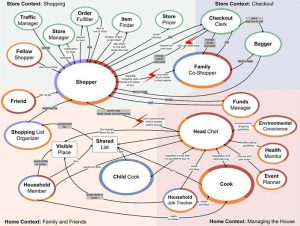How Contextual Design Can Improve
Getting to know your users is the foundation of any product development process. Contextual Design is an iterative and participatory method for learning about users that takes time and patience. It can be especially useful for enterprise-scale projects where many teams work on different parts of the system over years to accomplish business goals. Contextual Design can help ensure that engineering tradeoffs don’t degrade usability and user experience along the way.
The core of the Contextual Design process is contextual inquiry — observing and interviewing users in their daily contexts to understand their real worlds and tasks. Unlike the focus groups and interviews of traditional UX research, a Contextual Design interviewer does not come in with a set list of questions or prompts. Rather, they adopt the role of master apprentice and ask users questions about their work as they observe them working. The aim is to uncover tacit aspects of user behavior that are not easily reflected in self-reported data or lab-based testing, like interruptions, superstitious behaviors, and illogical processes.

This is a powerful and often overlooked method for discovering useful design data about users’ day-to-day experiences. It also reveals low-level details that are often taken for granted and can be barriers to user productivity and satisfaction – for example, when work is interrupted by unexpected events or when the system fails to meet expectations because of seemingly insignificant but important constraints.
How Contextual Design Can Improve Accessibility and Inclusivity
In the final step of Contextual Design, a team uses consolidated insights from this research to invent a technology solution that transforms their users’ work practices. This is done through visioning, where the team works through an iterative process to find solutions that solve the problems they uncovered through contextual inquiry and that are aligned with users’ needs, goals, and priorities.
One of the main differences between Contextual Design and other popular software development methods, such as Agile and FDD, is that contextual design places a greater emphasis on doing field research and taking time to carefully analyze and evaluate results before features are developed. This can result in a longer lead time to the first version of a new product. It is also less iterative than more rapid design approaches.
However, by deliberately placing an emphasis on being intentional and thorough, it allows the team to focus on developing quality user experiences. The resulting products are more likely to be used and understood by their users. In addition, using this approach can help to build a culture of user-centered thinking within an organization. This in turn can lead to a more innovative and productive workforce.
This has been proven in numerous studies, including a recent paper by Boehm and colleagues. The authors found that companies with high levels of user-centered design activity have higher customer and employee satisfaction. Moreover, these firms are more successful in meeting their revenue and profit targets than those with lower user-centered design efforts. Lastly, a more iterative design process is a great way to introduce new technologies to users, who are less likely to be resistant to change as the new technology becomes more familiar.